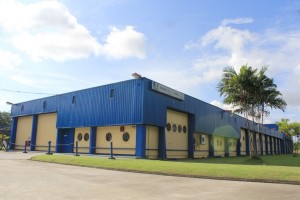
NEW GPC INC is continuing its tradition of excellence, says General Manager Ravie Ramcharitar, adding that the company underwent an audit from America’s Food and Drug Administration (FDA) in 2012.
Ramcharitar said the company can now boast of continued certification from this extremely stringent authority to manufacture and export to the U. S. He said NEW GPC had always exported its products to the U.S. and they are registered for sale in that country, noting that this is further reinforcement of the company’s standing as a world-class manufacturer in the pharmaceutical arena.
“NEW GPC is possibly the only company in this region to be certified by the U.S. FDA,” said the general manager. “The company is also licenced by the Guyana government’s Food and Drug Analyst Department.”
Ramcharitar stated that, on the heels of this achievement, the company plans to publish a series of articles that looks back at its privatization, the passage over the years featuring the major achievements, the people behind the company, and some of the exciting plans that are currently unfolding.
A successful privatization
The Guyana Pharmaceutical Corporation (GPC) started out as part of the Bookers Group of Companies, which apart from owning most of the sugar industry in colonial Guyana, also had wide commercial interests. Not without much truth, the common name for the colony, “BG”, was said to be an acronym for “Bookers Guyana”.
In the 1920s, Bookers Drug Store was formed to manufacture medicines, which, up to then, had all been imported into then British Guiana. It expanded to encompass a wide range of over-the-counter drugs, such as Limacol and Ferrol, which earned wide brand recognition in the Caribbean.
After the parent company was nationalised in 1976 — and renamed the Guyana Pharmaceutical Corporation Limited — it became the major supplier of pharmaceuticals to the government of Guyana and the health sector. But as with all the other commercial enterprises the government had nationalised, the company was run more on political rather than commercial lines. Like the others, it inevitably began to shrink and lose money.
Privatisation
As part of the International Monetary Fund (IMF) programme imposed on Guyana under the People’s National Congress (PNC) in 1989, GPC was scheduled to be privatised in the second phase — under the new People’s Progressive Party (PPP/C) government as it happened.
Unlike those conducted by the PNC in Phase One, the sale of GPC was advertised locally in 1999.
The PPP/C had moved very forcefully to make the privatisation process more transparent. “Of the six bids received, three were shortlisted for further evaluation. The other three were eliminated due to the failure to respond and submit much of the required information. Overall, the one bidder who has been consistent and the most honest in the submission of all information was Queens Atlantic Investment Inc (QAII),” according to the Privatisation Unit. QAII was headed by a local doctor, Dr Ranjisinghi Ramroop.
Privatised in parts
The sale was consummated in December 1999 when QAII paid Gy$ 458 million for 60 percent of the shares of the company, which it renamed NEW GPC INC, and incorporated under the Companies Act 1991. In addition, onto the NEW GPC was foisted “loans” extended to the old GPC by the New York financier Warburg Group to the tune of some Gy$ 200 million.
The PNC government had used this “loan” facility to cover all sorts of secret deals made by their political directorate.
According to the IMF Report of 1997, the total GPC asset base was valued at Gy$ 706 million, but what is often overlooked is that, as the latest report by the National Industrial and Commercial Investments Limited (NICIL) concedes, “GPC was privatised in parts”. The GPC property at 201 Camp Street, Georgetown, which housed Sijan Plaza, was sold to what became Citizens Bank for Gy$ 247 million.
The GPC’s head office at Ruimveldt Public Road, Georgetown, which had manufacturing facilities for Limacol, among other products, and most importantly a shipping wharf, were also stripped from the company and sold to the Guyana National Shipping Corporation (GNSC) for Gy$ 344 million. It was clear in retrospect that the new company had bought a “pig in a poke”. It is ironic that when the government sold a further 30 percent of the company for Gy$ 200 million to the NEW GPC, which exercised its first option clause, there were some complaints.
Based on how the assets were stripped, the NEW GPC should have received a refund. The remainder of the 10 percent shares is held by the government in trust for the employees.
But unlike what some others have done with their privatised companies, the NEW GPC owners buckled down to create one of the most successful private companies in Guyana.
It demonstrated that a well run private enterprise company can be successful.



